Canadian Pacific Railway
The Canadian Pacific Railway (CPR) is a railway company with almost 22,300 kilometres of standard-gauge rail network in Canada and the USA. It is, along with Canadian National Railway, one of Canada's two Class 1 railway companies. Listed on the Toronto Stock Exchange's S&P/TSX 60, the company is headquartered in Calgary. The company's main line, the Transcontinental Link, built between 1881 and 1885, runs between Montréal to the east and Vancouver to the west. The construction of the line fulfilled a promise to the province of British Columbia, which had joined the Canadian Confederation in 1871 and demanded a transportation link to the east of the country. The line contributed significantly to the settlement of the Canadian prairie provinces of Alberta, Manitoba and Saskatchewan. Today, the Canadian Pacific Railway operates freight services only, after passenger services were transferred to VIA Rail in 1978.
Canadian Pacific Railway was part of Canadian Pacific Limited, the world's largest transportation and natural resources group (shipping, aviation, rail, trucking, telecommunications, mining, oil, natural gas) from 1971 to 2001. During the period from 1968 to 1996, rail services were marketed under the name CP Rail. In 1996, a reorganization of the entire group took place. Five separate subsidiaries were formed, including Canadian Pacific Railway Limited, which took over the railway business. Effective October 1, 2001, the individual subsidiaries became legally and economically independent companies, while the group dissolved.
In the USA, Canadian Pacific Railway operates the two subsidiaries Soo Line Railroad and Delaware and Hudson Railway (D&H).
On March 21, 2021, Canadian Pacific Railway and Kansas City Southern (KCS) announced the acquisition of KCS by CP.
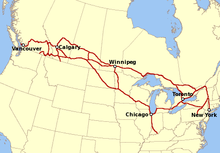
Main lines of the Canadian Pacific Railway

Former logo of the Canadian Pacific Railway
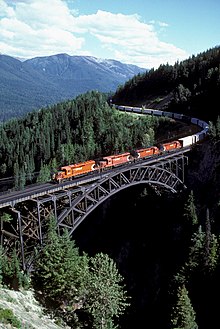
An eastbound freight train on the Stoney Creek Bridge near Rogers Pass (1988).
History
The time before the Canadian Pacific Railway (1871 to 1881)
The Canadian Pacific Railway was built for several reasons. The Conservative government of Prime Minister John Macdonald had promised British Columbia in 1871 that it would build a rail link between the Pacific and the eastern provinces in return for the new province joining the Canadian Confederation. The ten-year deadline for building the line began to run on July 21, 1871. Macdonald saw the railway as a means of creating a united Canadian nation and strengthening a sense of belonging. In addition, industrial companies in Quebec and Ontario were interested in gaining access to raw materials in the Canadian west and opening up new markets.
The main obstacle to construction was the high cost. The cheapest route for a railway to western Canada would have been through the US Midwest and Chicago, but it was to be an all-Canadian railway. The difficulty and expense of building a railway across the Rocky Mountains was obvious. Added to this was the crossing of an area over 1600 kilometres wide that was deserted in the Canadian Shield and Muskeg, the swampy tundra of northern Ontario. To secure the route, the government granted extensive concessions, including the right to acquire vast tracts of land along the route at virtually zero cost.
In 1872, the Canada Pacific Railway Company (not the same as today's company), led by Hugh Allan, was awarded the contract to build the line, while the Inter-Ocean Railway Company came away empty-handed. But Prime Minister Macdonald and other high-ranking politicians had taken bribes, leading to the Pacific scandal. The Conservative government was forced to resign in 1873 in the wake of the scandal; an early House of Commons election was held on January 22, 1874. The new government under Prime Minister Alexander Mackenzie (Liberal Party of Canada) ordered the start of construction of the first sections under government direction.
Construction of the section in the Thunder Bay district between Lake Superior and Winnipeg began in 1875, and progress was extremely slow and discouraging due to lack of public funds. When John Macdonald returned to power on October 16, 1878, a more aggressive building policy was adopted. Macdonald confirmed earlier plans that the starting point would be at Port Moody in British Columbia. He announced that the railway line would run from Port Moody along the Fraser River and the Thompson River to Kamloops.
In 1879, tenders were invited for the 206-kilometre section between Yale and the Savona ferry at Kamloops Lake. The contract went to contractor Andrew Onderdonk, whose workers began construction on May 15, 1880. Upon completion of this section, he was awarded the contract to build two other sections; between Yale and Port Moody and between Savona and Eagle Pass.
On October 21, 1880, a new Canadian Pacific Railway Company (with no connection to Hugh Allan) signed a contract with the Macdonald government. The CPR undertook to build the rest of the line. In return, it received a loan of 25 million Canadian dollars (today's value: about 385 million euros) from the government, as well as 25 million acres (about 101,000 km²) of land along the railway line. The government transferred the sections built under state control to the CPR. It also assumed the cost of land surveying and waived property taxes for the next twenty years. The contract became law on February 15, 1881, and the company was formally incorporated the following day.
The construction of the transcontinental railway (1881 to 1885)
It was generally assumed that the railway would pass through the "Fertile Belt", the valley of the North Saskatchewan River, and cross the Rocky Mountains at Yellowhead Pass. This route over the lowest pass in the watershed had been proposed by Sandford Fleming after ten years of planning and surveying. However, the CPR rejected these plans in favour of a route further south across the arid Palliser Triangle in Saskatchewan and over Kicking Horse Pass. This route was more direct and was far closer to the U.S. border. The CPR was thus able to largely block American railway companies' access to the Canadian market.
But the route also had several disadvantages. The CPR had to find a way through the Selkirk Mountains; this at a time when it was not even known if one existed. The task of finding a pass crossing was given to surveyor Albert Bowman Rogers. The CPR promised him a check for $5,000 and assured that the pass would be named after him. Rogers found this pass on May 29, 1881, and the railroad company honored the promise, christened the crossing Rogers Pass, and presented the check. Rogers initially refused to cash the check, however, framing it instead and saying he had done so not for money but for glory. Eventually, the CPR was able to get him to cash it when they put an engraved watch on it.
Another obstacle was that the proposed route ran through Blackfoot Indian territory. The missionary Albert Lacombe was finally able to convince Chief Crowfoot that the construction of the railway was ultimately inevitable. In return for his agreement, Crowfoot received a subscription to the CPR that was valid for life. Another disadvantage of the chosen route was that, unlike the alternative proposed by Sandford Fleming, the land along the railway line was often too arid to farm. The CPR had relied too much on the statements of the naturalist John Macoun. The latter had crossed the prairie in rainy weather and reported that the area was fertile, but in the end this was not entirely true. For this reason, the CPR could hardly sell land to settlers.
The biggest drawback of the route, however, was the transition at Kicking Horse Pass. For the first six kilometres west of the 1625-metre-high pass, the terrain drops abruptly by 350 metres. In 1884, therefore, the CPR, suffering from a chronic shortage of cash, was forced to build a very direct seven-kilometre section with a high gradient of 4.5%. This was four times higher than the maximum gradient recommended for railway lines at the time. Even today, railway lines are rarely steeper than 2%. Safety switches were installed at several points on the section that became legendary as the "Big Hill". The maximum speed allowed for downhill trains was 10 km/h, and special locomotives with particularly powerful brakes were purchased. Nevertheless, derailments occurred time and again. It was not until 1909 that the dangerous section was lifted thanks to the opening of two helical tunnels, the so-called Spiral Tunnels.
In the eyes of those responsible, construction progress in 1881 had been far too slow. One year later, CPR president George Stephen therefore engaged the renowned American railway manager William Cornelius Van Horne to drive the project forward. Van Horne promised to complete 800 kilometres of railway line within a year. Although numerous floods delayed the start of the construction season (work was suspended during the winter), more than 672 kilometres of main line and numerous sidings and branch lines were completed that year. The branch line to Thunder Bay was completed by the Canadian Railways and Canals Department in June 1882 and transferred to the CPR in May 1883. This made it possible for the first time to travel by water and rail from eastern Canada to Winnipeg. By the end of 1883, the east side of the Rocky Mountains had been reached. In the construction seasons of 1884 and 1885, work concentrated on the Rocky Mountains and the north shore of Lake Superior.
Many thousands of laborers (called navvies) worked on the line. Most were European immigrants. In British Columbia, the CPR also hired workers from Imperial China. A navvy earned between $1 and $2.50 a day, but had to pay for his own food, clothing, transportation to the construction site, mail, and medical treatment. Thus, with two and a half months of bone-jarring labor, the most they could earn was $16. The Chinese workers were even paid only between $0.75 and $1.25 per day, which meant they could hardly ever make remittances home. The Chinese took on the most dangerous jobs, such as handling dynamite. The families of the Chinese who perished received no compensation, or even news of their relative's death. Many of those who survived did not have enough money to return to China and had to survive in squalid conditions for years. Boys as young as twelve were used as teaboys.
In 1883, work progressed rapidly, but the CPR slowly ran out of money. In response, Parliament passed the Railway Relief Bill and granted the CPR a $22.5 million bond. The bill became law on March 6, 1884.
In March 1885, the Northwest Rebellion broke out in Saskatchewan as the Métis sought to gain their own province. Van Horne, who was in Ottawa at the time, promised the government that the CPR could transport troops to Fort Qu'Appelle within eleven days. Some sections were still unfinished or had not yet been travelled, but transportation to the war zone ultimately took only nine days and the rebellion was quickly put down. The government showed itself exceedingly generous for services rendered, assuming the debts of the CPR and granting another bond of $5 million.
On November 7, 1885, Lord Strathcona put the symbolic final nail in Craigellachie; thus the promise to British Columbia could finally be fulfilled. It was true that four years had already elapsed since the first agreed date. But the line was handed over more than five years before the second date (1891), which John Macdonald had renegotiated in 1881. Despite delays and political scandals, the successful completion of the project was an engineering and political feat for a country with a small population, limited financial resources and difficult terrain. At the time, the Trans-Canadian Railway was one of the longest lines in the world.
In the meantime, the CPR had built a network of connecting lines in eastern Canada between Quebec and St. Thomas. To this end, the subsidiary Ontario and Quebec Railway (O&C) acquired and leased numerous small companies. To connect the new acquisitions with the CPR line, the O&C built a line between Toronto and Perth, which opened on May 5, 1884. Four months earlier, the CPR had signed a 999-year lease with the O&C.
1886 until 1900
So many cost-cutting measures had been taken during the construction of the transcontinental link that operations could not begin until seven months after the official opening, as the condition of the line had to be improved in numerous places. But without the cost-cutting measures, the CPR would probably have run out of money prematurely and the line would have remained unfinished. The first passenger train departed Montreal on June 28 and arrived at Port Moody on July 4, 1886, but the CPR had since decided to move the western terminus a few miles to a small hamlet that was named Vancouver by the end of the year. The first official train reached Vancouver on May 23, 1887; however, the first trial runs had taken place three months earlier. The CPR soon became profitable and was able to repay all government bonds years before their maturity date.
In 1888, a branch line opened between Greater Sudbury and Sault Ste. Marie, connecting to the United States rail network. In the same year, construction began between London and Windsor (across from Detroit). This line opened on June 12, 1890. The CPR built some short lines east of Montreal and leased the New Brunswick Railway for 999 years. In 1889, it also built the International Railway of Maine; this ran a short distance over U.S. territory and connected Montreal with Saint John, New Brunswick's largest city. The CPR had thus closed the last gap between the Pacific and the Atlantic. From now on, travellers and goods could be transported between the oceans even when the Gulf of Saint Lawrence was frozen over and access to the Port of Montreal was blocked.
By 1896, competition with the Great Northern Railway in British Columbia had intensified to such an extent that the CPR had to build another line south of the original. Van Horne asked the government for support. The government pledged $3.6 million to build a line from Lethbridge over Crowsnest Pass to the south shore of Kootenay Lake. In return, the CPR was required to reduce freight rates for key commodities in perpetuity. The line over Crowsnest Pass could be opened on June 18, 1899.
The controversial Crowsnest Pass Agreement froze rates for eastbound shipments of wheat and westbound shipments of "settler goods" at 1897 levels. Although the agreement had been temporarily suspended during World War II, it was not until 1983 that it was replaced by the Western Grain Transportation Act. It was only from then on that freight rates for wheat could be gradually increased.
In 1888, the CPR entered the tourism business. In order to attract wealthy tourists from eastern Canada to the picturesque mountain world of the Rocky Mountains, it had a series of exclusive luxury hotels built along the transcontinental railway line, the Canadian Pacific Hotels. Later, more hotels followed in the major cities of the East. The most famous example is the ChâteauFrontenac, which has since become a tourist attraction in Québec.
1901 until 1928
During the first decade of the 20th century, the CPR built more lines. In 1908, it opened the direct connection between Toronto and Greater Sudbury. Before that, trains had to take a long detour through eastern Ontario.
In 1909, the opening of two structures brought about a marked improvement in operating conditions in western Canada. The first structure was the spiral tunnels, which alleviated the steep section on "Big Hill". The two helical tunnels reduced the maximum gradient from 4.5% to 2.2% from August 1909. On November 3, 1909, the Lethbridge Viaduct across the Oldman River valley was opened near Lethbridge, Alberta. With a length of 1,624 metres and a maximum height of 96 metres, the viaduct is the longest all-steel railway bridge in the world. The section over Rogers Pass was constantly threatened by avalanches in winter. It was replaced in 1916 by the eight-kilometre-long Connaught Tunnel under Mount Macdonald.
The CPR acquired numerous small railway companies by means of long-term leases. On January 3, 1912, it acquired the Dominion Atlantic Railway in western Nova Scotia. This gave the CPR access to Halifax, an important port on the Atlantic. It connected to the trunk line at Saint John with a rail ferry across Fundy Bay. On July 1, 1912, the CPR acquired the Esquimalt and Nanaimo Railway on Vancouver Island, which was also connected to the trunk network by rail ferry. This was followed by the purchase of the Quebec Central Railway on December 14, 1912.
After the outbreak of the First World War in 1914, the CPR put its resources at the service of the Canadian war effort. While other companies struggled for economic survival, the CPR was always able to turn a profit. After the war, the government created the Canadian National Railway (CNR, later CN) from the remnants of numerous bankrupt railway companies that had come into government ownership. CNR was to become CPR's main competitor.
Great Depression and Second World War (1929 to 1945)
The Great Depression, which lasted from 1929 to 1939, hit many companies hard. The CPR, unlike the CNR, was less affected as it was debt-free. Nevertheless, the CPR had to stop passenger and freight services on some routes and after 1932 had to refrain from paying dividends to shareholders.
A highlight for both the Society and Canada was the visit of King George VI and Queen Elizabeth in 1939. It was the first time ever that the British monarch, the head of state of Canada, visited the country. The CPR and the CNR shared the honour of pulling the royal train across the country. The CPR was responsible for the journey west between Quebec and Vancouver, the CNR for the return.
Shortly thereafter, World War II began. Now, too, the CPR put itself at the service of the nation and made many resources available. The locomotive shop in Montréal was converted and used to build Valentine tanks. Troops and materiel were transported across the country. The CPR owned 22 ships, 12 of which were sunk.
1946 until 1978
On 1 September 1947, a serious railway accident occurred in which 31 people died and 85 more were injured. The high number of casualties resulted not least from the fact that the CPR at that time was still using passenger coaches of older design with wooden bodies and partly still with gas lighting, which caught fire after the collision of the two trains. As a consequence of the accident, the wagons with wooden bodies were replaced at the CPR with wagons constructed entirely of steel.
→ Main article: Dugald railway accident
After the Second World War, transportation in Canada changed fundamentally. Previously, railways had handled almost all passenger and freight traffic, but now private cars, trucks and airplanes were gaining more and more market share. The CPR got into the trucking and airline business and was able to remain profitable as a result. Rail freight continued to flourish thanks to the transport of raw materials and bulk goods. But passenger transport quickly became unprofitable. Nevertheless, the company was innovative in passenger service during the 1950s, introducing many new trains, including the Canadian, a luxury transcontinental train in 1955. By the early 1960s, however, the company began to withdraw from passenger service, discontinuing operations on numerous branch lines. It sided The Dominion transcontinental train in 1966, but failed in its application to discontinue the Canadian as well in 1970. Finally, in 1978, all CPR and CN passenger services were transferred to the new state-owned VIA Rail.
In 1968, a reorganization of the entire group took place. All of CPR's main activities, including the operation of the railways, were spun off into separate subsidiaries. The name of the railways was changed to CP Rail and the parent company was named Canadian Pacific Limited in 1971. The company replaced the traditional Beaver logo with a plain typeface that could be used for all lines of operations.
1979 until today
In 1984, CP Rail began construction of the Mount Macdonald Tunnel to relieve the Connaught Tunnel under the Selkirk Mountains. It was opened in 1988 and, with a length of 14.7 kilometres, is the longest tunnel on the American continent.
During the 1980s, the Soo Line Railroad, in which CP Rail owned a majority stake, underwent a restructuring. It acquired the Minneapolis, Northfield and Southern Railway in 1982. On February 21, 1985, the Soo Line gained control of the Milwaukee Road and took it over permanently on January 1, 1986. In 1987, much of the former Soo lines in the Great Lakes region were sold to a new company, Wisconsin Central Ltd. This was acquired by the Canadian National Railway shortly thereafter.
Encouraged by the Canada-US Free Trade Agreement, which came into force in 1989 and liberalized trade between the two countries, CPR's expansion continued in the 1990s. In 1990, CP Rail gained full control of the Soo Line and in 1991 purchased the Delaware and Hudson Railway. This brought CP Rail's route network to the major U.S. metropolitan areas of Chicago (via the Soo Line) and New York (via the D&H). Over the next five years, the route network in Canada shrank as numerous routes were sold or closed. These included all routes east of Montréal, including the route to the Port of Saint John.
In order to do justice to the increased importance of westbound traffic, CP Rail moved its headquarters from Montréal to Calgary in 1996, reassumed the traditional name Canadian Pacific Railway and also reintroduced the old logo. A new subsidiary, the St. Lawrence and Hudson Railway, was formed to operate the Quebec, Southern and Eastern Ontario lines, as well as the D&H. However, this move was short-term in nature, as the StL&H had already been reintegrated into the CPR on January 1, 2001. In the same year, the parent company, Canadian Pacific Limited, converted its five subsidiaries (of which CPR was one) into independent companies.
In September 2007, Canadian Pacific announced the acquisition of the Dakota, Minnesota and Eastern Railroad (DME) and its subsidiary Iowa, Chicago and Eastern Railroad for $1.48 billion. DME received approval to build a rail line into the Powder River Basin coalfield in the spring of 2007, but had trouble securing financing. This merger gives CPR the opportunity to enter this lucrative business. Pending approval by the Surface Transportation Board, CP Rail's shares are held in trust.
At the end of November 2019, the company announced that it had entered into an agreement to acquire the Central Maine and Quebec Railway. This adds 774 kilometres to the route network, which extends east of Montreal in the states of Quebec (Canada) and Maine (USA). It also gives the company direct access to the Atlantic ports of Searsport and Saint John.
In March 2021, it becomes public that a "mega merger" with Kansas City Southern is planned. For the first time, this would create a provider of freight train services with a track connection from Canada via the USA to Mexico.
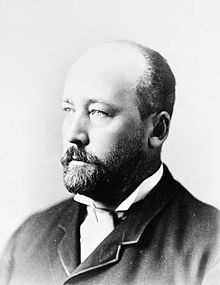
William Cornelius Van Horne

Lord Strathcona puts the final nail in Craigellachie
.jpg)
Memorial "Last Spike", Craigellachie
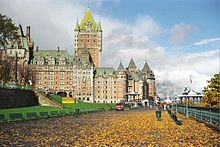
Château Frontenac in Québec
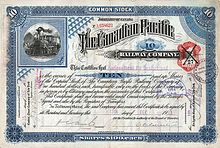
Share of the Canadian Pacific Railway Company dated December 3, 1913
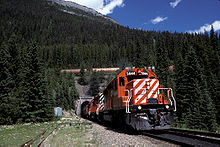
A CPR train leaving the lower of the two spiral tunnels

Logo of CP Rail from 1971

A locomotive of the Soo Line in Wisconsin
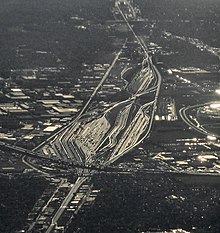
The CPR's Bensenville Yard in the Chicago metropolitan area, formerly Milwaukee Road.

John Macdonald
Freight
More than half of the Canadian Pacific Railway's freight traffic consists of the transport of coal, wheat and containers (which are later loaded onto ships). The CPR also transports auto parts, sulphur, fertilizer, chemicals, lumber as well as other commodities. The busiest route is the main line between Calgary and Vancouver.
Since 1970, coal transportation has become significantly more important. The coal is transported from the coal mines in the mountains to the terminals at Roberts Bank and North Vancouver, both in British Columbia, by freight trains built for this purpose alone. There it is then loaded onto ships that manage its transport to Japan. Every year, the CPR transports 34 million tonnes of coal to the West Coast.
Wheat is transported by the CPR from the Prairies to the ports of Thunder Bay and Fort William on Lake Superior, and to Vancouver for shipment overseas. Wheat has always been one of the CPR's most important commodities. Between 1905 and 1909, it upgraded the line between Winnipeg and Fort William to two tracks for the sole purpose of better handling wheat shipments. For several decades, this was the only double-track section of the CPR outside the metropolitan areas.
In 1952, CPR became the first North American railroad to introduce piggyback service, in which truck trailers are loaded onto flat cars and transported over long distances.
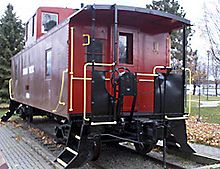
Historic CP Rail caboose outside the Brockville Tunnel in Ontario.
Questions and Answers
Q: What is the Canadian Pacific Railway (CPR)?
A: The Canadian Pacific Railway (CPR) is a railway in North America with track in both Canada and the United States. It was built between Eastern Canada and British Columbia between 1881 and 1885.
Q: Why was the CPR built?
A: The CPR was built as part of a promise made by the federal government when British Columbia became part of Canada in 1871, to link it to the rest of Canada by rail.
Q: What does the CPR mainly transport?
A: Most of the trains that use the CPR carry freight, although it used to run passenger train services until they were taken over by Via Rail in 1978.
Q: How did the CPR contribute to Western Canada's development?
A: For many years, until airplanes were invented, railways were the only way to move people across countries. Because of this, it had a big role in settlement and development of Western Canada.
Q: Who owns CP Rail?
A: CP Rail is owned by Canadian Pacific Railway Limited, which used to be one of largest and most powerful companies in Canada.
Q: How much track does CP Rail own? A: CP Rail owns about 20,000 kilometres (12,500 mi) of track from Montreal in East to Vancouver in West and Edmonton to North as well as track in Minneapolis-Saint Paul, Milwaukee, Detroit Chicago and New York City in US.
Q: What is CP's logo? A:The logo for CP Rail is a beaver which is also known as national symbol for Canada.
Search within the encyclopedia